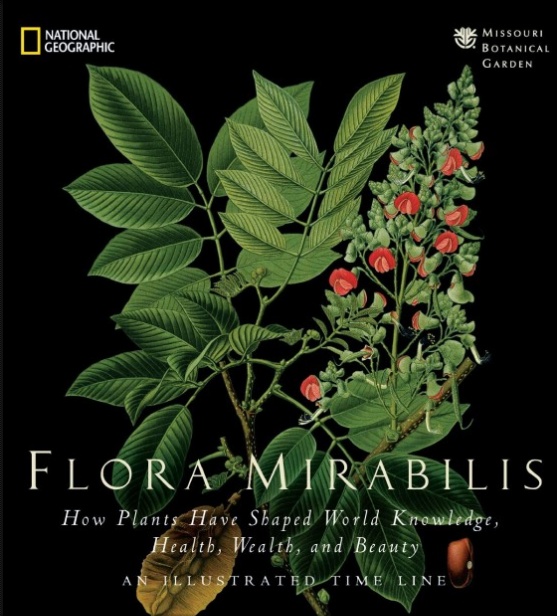
A few months ago Susan Tyler Hitchcock of the National Geographic Society* kindly provided us with a copy of Flora Mirabilis by Catherine Herbert Howell. Whoever said you cannot judge a book by its cover had obviously not seen this book. The stories of the 27 plants that "shaped world knowledge, health, wealth, and beauty" are told convincingly with narrative and illustration. The latter is the best feature of the book and the focus of our review. By the way, the 27 plants are date palm, wheat, rice, olive; black pepper, sugarcane, maize, citrus, tulip; tobacco, tea, coffee, peppers, cinchona; tomato rose, grape, cotton, apple; cannabis, rubber, potato, opium poppy, orchids; and bamboo, yam, cacao.)
The first illustrations that greet the eyes are the ones on the book's jacket. The cover features the Jamaica dogwood (Piscidia erythrina or P. piscipula) and the spine, the Tiger lily (Lilium spp.) both from the collections of the Missouri Botanical Garden Library.
 |
| Primula sinensis (pages 96-97) |
 |
| Strelitzia reginae (page 98) |
Each chapter is preceded by double-page spread and single-page illustrations. For example, Chapter 3: Exploration 1650-1770 opens with a two page spread of the Chinese primula (Primula sinensis)** followed by a single page illustration of the bird-of-paradise (Strelitzia reginae). From the latter image you can see why the plant was thought to resemble a bird.
 |
| Camellia sinensis (page 112) |
Sections are organized by plants that represent the chapter's theme. Each section has a facing page illustration of its respective plant. Thus, for Chapter 3, the featured plants are tobacco (Nicotiana spp.), tea (Camellia sinensis), coffee (Coffea arabica), peppers (Capsicum spp.), and cinchona or fever-tree (Cinchona officinalis).
Within chapters there are other illustrations such as of important figures, social milieux, artifacts, and ethnobotanical products. An example is of a vessel of immature opium seedpods that were dispensed as "medicine as recently as the early 20th century" (page 205).
 |
| Container of opium seedpods |
The illustrated time line at the start of each chapter is a creative way of providing an overview of the period under discussion. Here is an example from Chapter 6: Science 1900 - Present (pages 220-221).
 |
| Chapter 6 time line |
Two plants - corn and soy - seem to be missing from the last chapter of the book, Science 1900-Present. According to the food media, corn and soy account for much of the modern American diet. There is mention but no substantive discussion of the development of high fructose corn syrup in the 1970s and the use of corn in ethanol.
Finally, in addition to desiring garden spots that would allow me to cultivate most of the featured plants, this botanical volume made me want to spend time in the Missouri Botanical Garden Library! Did you know that the Missouri Botanical Garden is "the nation's oldest botanical garden in continuous operation and a National Historic Landmark"?*** Flora Mirabilis is available wherever books are sold.
* Also thank you to Anna Kukelhaus of NGS.
** Pardon the quality of the images. With the exception of the first image, they were scanned with a 8.5 x 11 desktop scanner.
*** h/t L.A. at Home
Don't forget to enter the Emerald Cities book giveaway
To enter to win a copy of Emerald Cities by Joan Fitzgerald, simply answer the following question in the comments section of the original post: What sustainability projects are being pursued by your city or town?
Entries close at 11:59 p.m. on Tuesday, May 11, 2010. We will select one random winner from all the entries.
Comments
Post a Comment
Thank you for commenting on this post!